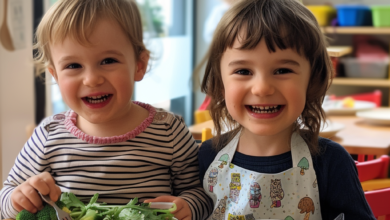Montessori Approach to Weaning: A Gentle Transition from Breastfeeding

- Child-Led Readiness
- Prepared Environment
- Encouragement of Self-Feeding
- Role of the Adult
- Gentle Transition
The Montessori approach, known for its emphasis on independence, respect for a child’s natural psychological, physical, and social development, offers a unique perspective on the weaning process. Weaning, the transition from breastfeeding or bottle-feeding to solid foods, is a significant milestone in a child’s life. This article explores the Montessori approach to weaning, providing insights and practical tips for a gentle transition.
Understanding Montessori Weaning
Montessori weaning is centered around the child’s readiness and willingness to explore solid foods, rather than adhering to a strict timeline. This Montessori method encourages parents to observe their child for signs of interest in solid foods and to introduce these new experiences in a supportive, child-led environment. The goal is to foster a positive relationship with food, self-feeding skills, and independence in eating.
Recognizing Readiness for Weaning
The first step in the Montessori approach to weaning is to recognize when your child is ready to begin the process. Signs of readiness may include sitting up with minimal support, showing interest in foods others are eating, and the ability to grasp small objects. These developmental milestones typically occur around six months of age but can vary from child to child.
Preparing the Environment
Creating a supportive environment is crucial for successful Montessori weaning. This includes setting up a child-sized weaning table and chair, where the child can sit comfortably and independently. The table should be stable and at a suitable height for the child to eat from. Providing child-sized utensils, plates, and cups can also encourage self-feeding and foster independence.
Introducing Solid Foods
Introducing solid foods in the Montessori approach is a gradual and respectful process. Begin with single-ingredient, soft foods that are easy for the child to manipulate and chew. Offer small amounts and allow the child to explore the textures and tastes at their own pace. It’s important to avoid forcing food and to respect the child’s appetite and preferences.
Encouraging Self-Feeding
Self-feeding is a key component of Montessori weaning. Encourage your child to use their fingers or child-sized utensils to feed themselves. This promotes fine motor skills, hand-eye coordination, and a sense of independence. It’s important to be patient and accepting of the mess that comes with learning to eat independently.
The Role of the Adult
In the Montessori approach, the role of the adult is to guide, support, and observe, rather than direct. Offer a variety of healthy foods and allow the child to choose what and how much to eat. Model positive eating habits and provide encouragement without pressuring the child to eat. Observing the child’s cues and respecting their autonomy is key.
Transitioning from Breastfeeding or Bottle-Feeding
The transition from breastfeeding or bottle-feeding to solid foods should be a gradual process that respects the child’s needs and pace. Continue to offer breastmilk or formula as the primary source of nutrition until the child is consuming a variety of solid foods. Gradually reduce the number of feedings as the child’s intake of solid foods increases.
Overcoming Challenges
Weaning can come with challenges, such as food refusal, messiness, and fluctuating interest in solid foods. Stay patient and flexible, and remember that each child’s weaning journey is unique. Offer a variety of foods, encourage exploration, and maintain a positive, stress-free mealtime environment.
Last Words
The Montessori approach to weaning is a gentle, child-led process that emphasizes independence, respect, and a positive relationship with food. By recognizing readiness, preparing the environment, encouraging self-feeding, and respecting the child’s pace, parents can support a smooth transition from breastfeeding or bottle-feeding to solid foods. This method not only nurtures the child’s physical development but also fosters self-confidence and autonomy in eating.
FAQ: Montessori Approach to Weaning
1. At what age should I start the Montessori weaning process?
The Montessori approach emphasizes following the child’s cues rather than a strict age guideline. However, many children begin to show signs of readiness for solid foods around 6 months of age. These signs include being able to sit up with minimal support, showing interest in what others are eating, and reaching for food. It’s important to observe your child and start the weaning process when they exhibit these readiness cues.
2. How do I know if my child is ready for solid foods?
Children ready for solid foods often display several key behaviors: sitting up with minimal support, showing curiosity about foods, reaching out for food, and the ability to grasp small objects. Additionally, the loss of the tongue-thrust reflex, which causes babies to push food out of their mouths, is another sign of readiness for starting solid foods.
3. What foods should I introduce first in the Montessori weaning process?
Begin with single-ingredient, soft foods that are easy for your child to mash with their gums. Foods such as ripe avocado, banana, cooked sweet potato, and soft-cooked vegetables like carrots or zucchini are good options. It’s recommended to introduce one food at a time and wait a few days before introducing another to monitor for any allergic reactions.
4. How can I encourage my child to self-feed?
To encourage self-feeding, offer your child a variety of finger foods that they can easily grasp and bring to their mouth. Use child-sized utensils, plates, and cups to facilitate independence. Sitting with your child during meals and eating together can also model self-feeding behavior. Remember, the goal is to encourage exploration and enjoyment of food, so be patient and expect some mess as part of the learning process.
5. What do I do if my child refuses to eat the foods offered?
It’s common for children to be hesitant about new foods. Offer a variety of foods without pressure, allowing your child to explore and taste at their own pace. If your child refuses a particular food, try reintroducing it at another time. Children may need to be exposed to a new food multiple times before accepting it. Ensure the mealtime environment is positive and stress-free, focusing on the experience of eating rather than the quantity of food consumed.




